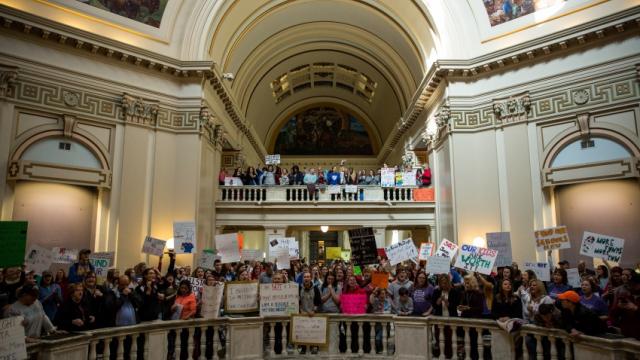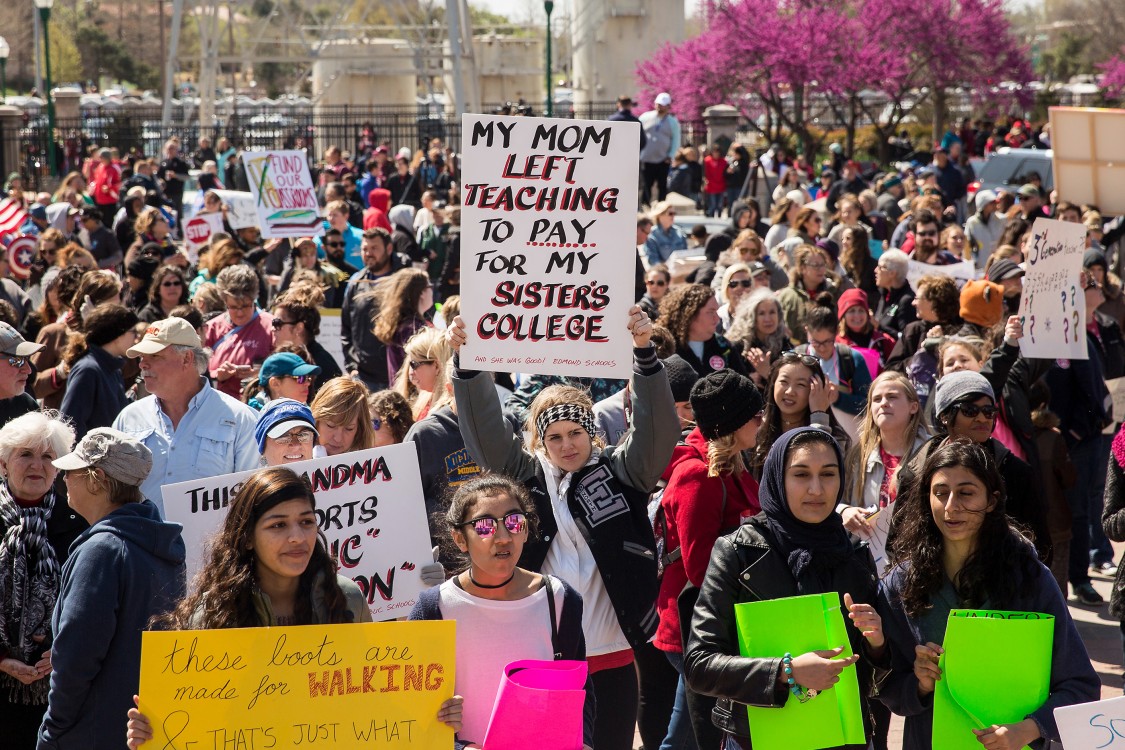
Teachers are staging rolling walkouts and mobilizations across Oklahoma. (Photo by Scott Heins/Getty Images)
On April 2, an estimated 30,000 Oklahoma teachers walked out of schools across the state, some traveling hundreds of miles to the capital to protest. This momentum has not stopped: At the time of this writing, teachers are marching—by foot—from Tulsa to Oklahoma City. Across the state, they are planning to continue to mobilize, despite legislative opposition that has gone so far as to accuse the teachers of bussing in protestors from Chicago.
To explain the reasons for the strike and ongoing mobilizations, most mainstream media have been marketing poverty porn: This teacher sells plasma. Another works six jobs to make ends meet. Some teachers in Oklahoma tell In These Times that major outlets are specifically only asking to speak with the poorest teachers.
But there’s a bigger issue at hand than the impoverished state of teachers and their support staff: privatization. For more than a decade, state legislators—Democrats and Republicans alike—have marched the state off the proverbial financial cliff, then used budget shortfalls to push privatization. For every notch the state’s economic belt is tightened, a private company comes in and takes over—at a cost largely unknown to Oklahomans.
Take, for example, the Oklahoma Department of Human Services (ODHS), which shifted the sheltering of some abused and neglected children to the private entity White Fields in 2006. Private institutions aren’t subject to the same level of open records requirements and accountability standards as state agencies are in Oklahoma, worries Connie Johnson, former state senator and Our Revolution candidate for governor.
This trend, alongside shrinking unions, is a factor behind Monday’s walkout, as well as protests continuing through the week and planned into the coming months.
Oklahoma should be a rich state. Oil derricks suck the Earth’s blood like mechanical mosquitos, from small-town backyards to the front and back lawn of the state capitol building in Oklahoma City. The state has a rich and long history of coal mining. Yet the oil, gas and coal industries have finagled low-to-no-tax schemes. Meanwhile, the poor pay a greater percentage of their incomes on state and local taxes than wealthier residents, and face sin taxes on cigarettes and alcohol.
Amid this climate, the Oklahoma legislature did pass an 11th hour bill on March 28 to fund teachers’ salaries with a raise that many consider insufficient. The question of how the state would fund the raise was left out, even though there was much self-congratulatory back-slapping among elected officials. “I hope [the teachers] can come up here and say 'thank you' on Monday and go back to the classrooms,” announced Oklahoma Gov. Mary Fallin (R).
But many Oklahomans were disgusted by the bill and the governor’s statement. State Rep. Karen Gaddis (D-Tulsa/Broken Arrow) wrote on her Facebook page:
"… it was nothing more than a bait-and-switch… THE BILL IS ALMOST $150M UNDERFUNDED! … the Legislature must either come up with new sources of revenue (… usually on the back of the common man) or cut the budget in other areas, like mental health services, drug and alcohol rehab services, higher ed, infrastructure, corrections, whatever."
State Rep. Roger Ford (R-Oklahoma City) agreed on his Facebook page: “I'm being told raises will be paid from ‘other’ revenue sources next fiscal year. So once again districts have to trust the legislature to fund education or the district will have another unfunded mandate on their back.”
Yet, some mainstream media outlets, including USA Today, painted the story of the teachers walking out after the bill was signed by the governor as if the teachers were ingrates.
Teachers express frustration with the legislature’s incompetence in passing an unfunded bill. “Every piece of legislation that comes, out it’s like, what now?” Julie Edenborough, 51, tells In These Times. She’s the director of Title III and Migrant Services for Guymon Public Schools—a tiny district in the Oklahoma panhandle, just north of the Texas border and hours away from the nearest shopping mall. She works with the migrant children of the farmworker community. She says in the last two years, the state has taken back money they had already budgeted to the district, three times.
Edenborough says it’s not just those cuts that hurt. It’s the cuts to the Department of Mental Health and Substance Abuse Services, which was directed to shed nearly 25 percent of its budget last Fall. “The Texas County Health Department is on the brink of closing,” she adds. “I need [those] core service[s] to be operational so the student is healthy and can learn. We have two caseworkers working a six-county area. They are over worked. They can’t take students in.” Children, she says, are being sent home into harm’s way for lack of state support.
“We’re hoping those other employees in those agencies will fight with us as well,” she says. “Every agency of the state is at a critical mass of breakage.”
Other state agencies, from Corrections to Mental Health to Transportation, are now complaining about their severely cut budgets, too.
The way Oklahoma funds public services has to be revisited, says Larry Cagle, a teacher and leader of the mobilization group Oklahoma Teachers United. “Those state workers have gone without a raise as much as we have.”
In addition, many school superintendents of public school systems and principals have been complicit, offering little to no support of the teachers, says Cagle. “They are working aggressively to force in a privatization of the schools,” he says. “That’s the real story.”
Cagle points to the Eli and Edythe Broad Foundation, an organization that seeks to run schools as private entities under the banner of “entrepreneurship for the public good.” He says this group is a key force pushing resources out of Oklahoma’s public schools and into private entities like charter schools.
Cagle says public school superintendents, principals and school board members across the state were trained by or are otherwise a part of Broad’s system. Tulsa Public Schools superintendent Deborah Gist, for example, is Broad trained, and designated a “Champion for Charters” by the National Alliance for Public Charter Schools when she was commissioner of Rhode Island’s public schools.
Cindy Decker is an elected school board member for Tulsa Public Schools and is also director of research and innovation at CAP Tulsa—a $65 million organization that is also opening early education centers in Tulsa public schools.
“Why is Cindy Decker allowed to be a school board member when [her organization] has contractual agreements with [public schools]—but a school administrator isn’t allowed to sit because of conflict of interest? Why do we allow private industry to have positions on the school board?” Cagle asks.
The strategy, he says, makes it easy for private education to move into poor minority communities, and then squeeze white districts until they succumb to privatization. KIPP, one of the charter school business lacerated by John Oliveron Last Week Tonightin 2016, has already taken over a large Tulsa minority high school.
But privatization of state services isn’t working: Last week, White Fields announced it was terminating its ODHS contract because it isn’t “set up to help the type of child we are being sent [mentally ill],” creating a new crisis in what to do with kids who need a place to go and a state completely unready to house them. But it’s hard to tally just how much money the state is spending on such privatization.
Support for the teachers and state workers resonates across the state. “My mom is a retired teacher,” says Chris Isbell, a pharmacist and owner of Johnny’s Hometown Pharmacy in Roland. “I very much support the teachers.”
Others think it’s time to vote new folks in. “I sympathize with the teachers,” says Tim Tanksley, of Bokoshe. “But sometimes I wonder how many of them, their families, what their party affiliations are, who they vote for, who they put in office. Sometimes I think a lot of them, they keep handing them back the stick and saying ‘hit me again. I haven’t suffered enough.’”
Cagle says the legislature is known to retaliate against teachers when they step out of line. For example, despite bipartisan agreement that the bill the governor signed on the 28this unfunded, the Tulsa World reported that State Rep. Kevin McDugle, (R-Broken Arrow) said, "I'm not voting for another stinking measure when [the teachers are] acting the way they're acting."
Despite the potential for retaliation, the teachers are more angry than afraid: Cagle says teachers from across the state are participating in ongoing, state-wide, marches and rolling walkouts. And despite popular stereotypes of Oklahomans as white and Republican, Oklahoma’s demographics have changed dramatically in 20 years. A third of the population is minority or mixed race. And in Guymon, dozens of languages are spoken in a student population of just 3,000.
Motivated, inspired, and hopeful for change from the bottom up, Edenborough says that 60 teachers from Guymon made the roughly five-hour drive to Oklahoma City to protest, leaving Easter Sunday afternoon. The other teachers are protesting locally in shifts, while still making sure the students are picked up by buses and are brought to school so they can eat breakfast and lunch. Edenborough says 85 percent of Guymon’s students receive free meals.
“You don’t grow stronger by starving people,” says Edenborough.
Possible solutions continue to fall short, and while the OEA issued demands to end the walkout, Oklahoma Teachers United is publicly not willing to end the ongoing work actions and protests before funding is secured for teachers and fellow public school and state employees.
Oklahoma, says Cagle, is “not a poor state. It’s a priority state,” meaning where the money goes demonstrates the priorities of the state. Clearly, he says, “the money in the state is going somewhere.” And the answer to where it’s going, he says, is in “the hands of the one percent.”
“They’re pumping it from our home,” he says. “It’s our oil. Our water. Our land. And people are waking up.”












